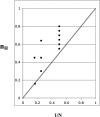An empirical extremum principle for the hill coefficient in ligand-protein interactions showing negative cooperativity
- PMID: 15834004
- PMCID: PMC1366580
- DOI: 10.1529/biophysj.105.060194
An empirical extremum principle for the hill coefficient in ligand-protein interactions showing negative cooperativity
Abstract
The Hill coefficient (nH) is a central parameter in the study of ligand-protein interactions, which measures the degree of cooperativity between subunits that bind the ligand in multisubunit proteins. The most common usage of nH is as an estimate of the minimal number of interacting binding sites in positively cooperating systems. In the present study, a statistical interpretation of nH for a generalized system of multiple identical binding sites is developed. This interpretation is then applied to the derivation of an empirical extremum principle for nH in negatively cooperating systems of identical binding sites, which can be used for the estimation of the minimal number of interacting sites in such systems.
Figures
References
-
- Hill, A. V. 1910. The possible effects of the aggregation of the molecules of haemoglobin on its oxygen dissociation curve. J. Physiol. (London). 40:4–7.
-
- Wyman, J. J. 1964. Linked functions and reciprocal effects in hemoglobin: a second look. Adv. Protein Chem. 19:223–286. - PubMed
-
- Weber, G., and S. J. Anderson. 1965. Multiplicity of binding. Range and practical test of Adair's equation. Biochemistry. 10:1942–1947.
-
- Dahlquist, F. W. 1978. The meaning of Scatchard and Hill plots. Methods Enzymol. 48:270–299. - PubMed
-
- Gill, S. J., H. T. Gaud, J. Wyman, and B. G. Barisas. 1978. Analysis of ligand binding curves in terms of species fractions. Biophys. Chem. 8:53–59. - PubMed
Publication types
MeSH terms
Substances
LinkOut - more resources
Full Text Sources


